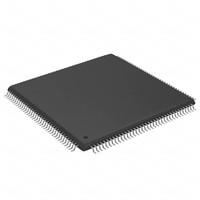

The XC2C256-7VQG100C, which has 256 macrocells, is designed for both high-performance and low-power applications. High-tech communication equipment can use less energy as a result, and battery-operated gadgets have exceptional speed. The dynamic operation and low power stand-by improve the overall system reliability.
This XC2C256-7VQG100C is made up of sixteen Function Blocks that are connected by the Advanced Interconnect Matrix (AIM), a low power interconnect architecture.The AIM sends 40 true and complement inputs to each Function Block. The Function Blocks are composed of a 40 by 56 P-term PLA and 16 macrocells with a number of configurable bits that enable combinational or registered modes of operation.
The 0.18 micron process technology used in the fabrication of XC2C256-7VQG100C is a byproduct of cutting-edge FPGA product development. RealDigital, a design methodology that uses CMOS technology in both the fabrication and design methods, is used by CoolRunner-II CPLDs. Instead of using the conventional sense amplifier approach, RealDigital design technology implements sums of products using a cascade of CMOS gates. This innovation enables the operation of Xilinx CoolRunner-II CPLDs at both high performance and low power.
I/O implementations for LVCMOS, LVTTL, SSTL, and HSTL are available on the XC2C256-7VQG100C’s 256 macrocell. A general-purpose EIA/JEDEC standard for 3.3V applications that use an LVTTL input buffer and Push-Pull output buffer is called the LVTTL I/O standard. Applications requiring 3.3V, 2.5V, and 1.8V use the LVCMOS standard. A VREF pin is used by the HSTL and SSTL I/O standards in order to comply with JEDEC. Schmitt-trigger inputs enable 1.5V I/O compatibility for CoolRunner-II CPLDs as well.
Open-drain output option for Wired-OR and LED drive
Optional bus-hold, 3-state or weak pull-up on selected I/O pins
Optional configurable grounds on unused I/Os
Mixed I/O voltages compatible with 1.5V, 1.8V, 2.5V, and 3.3V logic levels
IEEE1149.1 JTAG Boundary Scan Test
Optional Schmitt-trigger input (per pin)
Unsurpassed low power management
DataGATE enable (DGE) signal control
Two separate I/O banks
RealDigital 100% CMOS product term generation
Flexible clocking modes
The best platform for testing and implementing designs employing a high-performance, low-power CPLD is the Digilent CoolRunner-II CPLD starting board. Targeted applications span a wide range of sectors and include remote monitoring, wireless interfaces, and glue logic. It has below applications:
Remote monitoring
Wireless interfaces
Glue logic
Automotive driver assistance
Industrial motor control
Industrial networking
Machine vision
| Specification | Value |
|---|---|
| Frequency | 152 MHz |
| Supply Voltage (DC) | 1.70 V (min) |
| Number of I/O Pins | 80 |
| Product Lifecycle Status | Active |
| Packaging | Bulk |
| Mounting Style | Surface Mount |
| Number of Pins | 100 |
| Case/Package | QFP |
| RoHS | Compliant |
| Lead-Free Status | Lead Free |
| REACH SVHC Compliance | No SVHC |
| HK STC License | NLR |
| Series | CoolRunner II |
| Programmable Type | In System Programmable |
| Number of Macrocells | 256 |
| Number of Gates | 6000 |
| Operating Temperature | 0°C ~ 70°C (TA) |

Buy XC2C128-7TQG144C Xilinx, Inc, Get familiar with the XC2C128-7TQG144C CoolRunner-II CPLD at VEKEM...

Buy XC2C128-6CP132C Xilinx, Inc, Get familiar with the XC2C128-6CP132C CoolRunner-II CPLD at VEKEMO ...

Buy XC2C128-5VQG100I Xilinx, Inc, Get familiar with the XC2C128-5VQG100I CoolRunner-II CPLD at VEKEM...

Buy XC2C128-5VQG100C Xilinx, Inc, Get familiar with the XC2C128-5VQG100C CoolRunner-II CPLD at VEKEM...

Buy XC2C128-5VQ100I Xilinx, Inc, Get familiar with the XC2C128-5VQ100I CoolRunner-II CPLD at VEKEMO ...